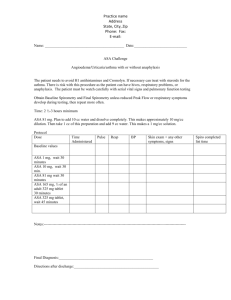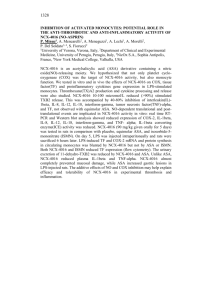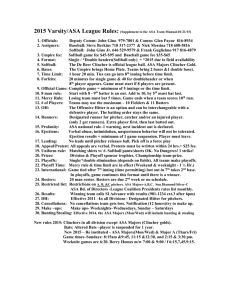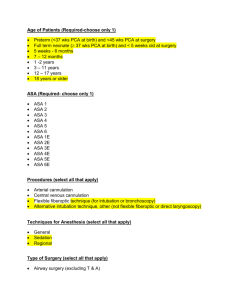document
advertisement
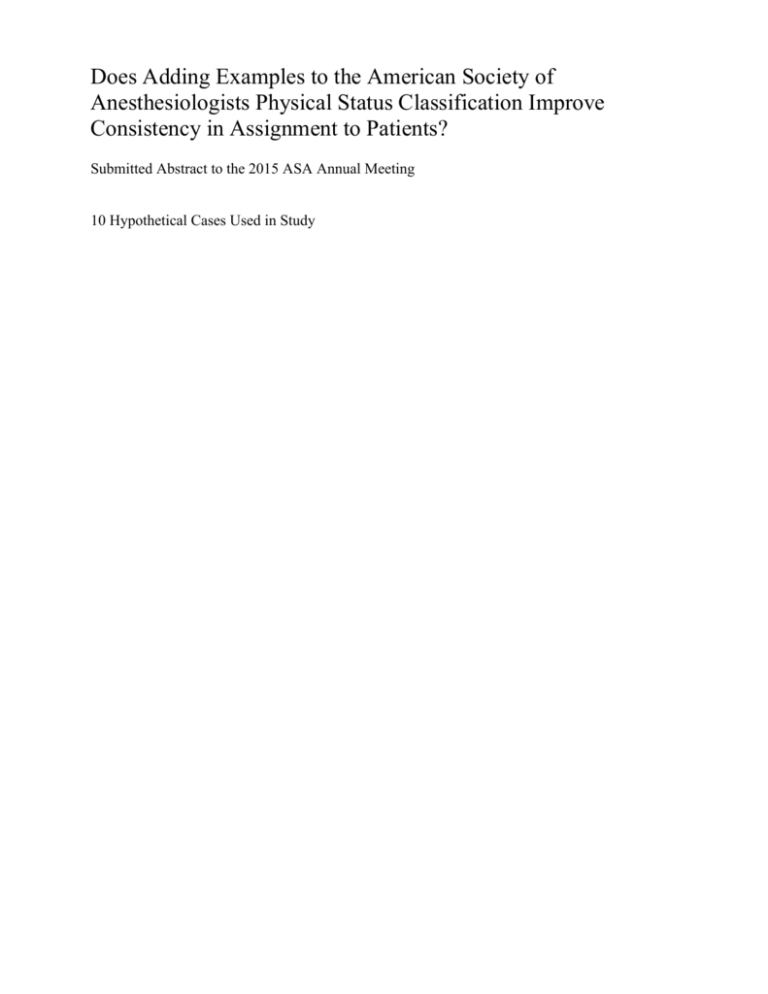
Does Adding Examples to the American Society of Anesthesiologists Physical Status Classification Improve Consistency in Assignment to Patients? Submitted Abstract to the 2015 ASA Annual Meeting 10 Hypothetical Cases Used in Study Table : Current Definitions and Examples of ASA Physical Status Class http://www.asahq.org/resources/clinical-­‐information/asa-­‐physical-­‐status-­‐classification-­‐system ASA PS Classification ASA I Definition Examples, including, but not limited to: A normal healthy patient Healthy, non-­‐smoking, no or minimal alcohol use A patient with mild systemic disease Mild diseases only without substantive functional limitations. Examples include (but not limited to): current smoker, social alcohol drinker, pregnancy, obesity (30<BMI<40), well-­‐controlled DM/HTN, mild lung disease ASA III A patient with severe systemic disease Substantive functional limitations; One or more moderate to severe diseases. Examples include (but not limited to): poorly controlled DM or HTN, COPD, morbid obesity (BMI ≥40), active hepatitis, Alcohol dependence or abuse, implanted pacemaker, moderate reduction in ejection fraction, ESRD undergoing regularly scheduled dialysis, premature infant PCA < 60 weeks, history (>3 months) of MI, CVA, TIA, or CAD/stents. ASA IV A patient with severe systemic disease that is a constant threat to life Examples include (but not limited to): Recent (< 3 months) history of MI, CVA, TIA, or CAD/stents. Ongoing cardiac ischemia or severe valve dysfunction, severe reduction of ejection fraction, sepsis, DIC, ARD or ESRD not undergoing regularly scheduled dialysis ASA V A moribund patient who is not expected to survive without the operation Examples include (but not limited to): Ruptured abdominal/thoracic aneurysm, massive trauma, intracranial bleed with mass effect, ischemic bowel in the face of significant cardiac pathology or multiple organ/system dysfunction ASA VI A declared brain-­‐dead patient whose organs are being removed for donor purposes ASA II *The addition of “E” denotes Emergency surgery: (An emergency is defined as existing when delay in treatment of the patient would lead to a significant increase in the threat to life or body part) Case 1: A 32-year-old male presents for gastric banding weight loss surgery. He is currently 5’6” and weighs 118 kg (BMI 42), after an intentional weight loss of 15 kg over the past 6 months. He has gastro-esophageal reflux disease that is controlled on omeprazole. He currently walks 2 miles per day on a treadmill without chest pain or shortness of breath. Preoperative blood pressure is 118/70, HR 84. ASA PS III Why? BMI>40 Case 2: A 53-year-old woman presents for bilateral breast augmentation. She has a past medical history of hypertension, esophageal reflux, and tobacco use. She is 5’5” and weighs 80 kg (BMI 29). Her blood pressure is usually controlled with her normal range of 120’s/70’s, however this morning her blood pressure is 154/99. She denies any chest pain or shortness of breath. She jogs 4-5 miles 2-3 times a week. Her reflux is well controlled on esomeprazole. She admits to smoking 2-3 cigarettes a day which is down from her usual 1/2 pack a day she’s been smoking for the past 30 years. No other significant medical history is obtained and on examination she is within normal limits. ASA PS II Why? Controlled HTN, controlled GERD, current smoker Case 3: A 56-year-old female presents for vaginal hysterectomy for uterine fibroids. She is 5’4” and weighs 73 kg (BMI 28). She has hypertension controlled on metoprolol. She has a 20 pack year smoking history but quit smoking 5 years ago and denies any recent respiratory infections. She was recently diagnosed with non-insulin dependent diabetes mellitus. Her most recent HbA1c is 10.5% and her fasting blood glucose the day of surgery is 250 mg/dL. ASA PS III Why? Controlled HTN, poorly controlled DM Case 4: A 26-year-old woman presents for ankle open reduction internal fixation after tripping on the sidewalk and fracturing her ankle. Her height is 5’2” and weight is 91 kg (BMI 37). She has a past medical history of asthma, for which she had an ER vist one year ago, no prior hospital admissions for asthma. She has since been on a daily steroid inhaler and montelukast. Her symptoms are well controlled on this regimen, and she has not needed her rescue inhaler in greater than 6 months. She admits to snoring at night and being told she has mild OSA after a sleep study. She has been noncompliant with her CPAP machine due to intolerance of the nasal mask. She complains of occasional gastroesophageal reflux, mostly related to foods she eats. She’s been told she has “pre-diabetes” and is trying to lose weight. She also has a history of epilepsy but hasn’t had a seizure in 3 years. The rest of her medical history is negative and her examination is within normal limits. ASA PS II Why? Controlled asthma, mild OSA, GERD, epilepsy, obesity (30<BMI<40) Case 5: An 82-year-old male presents for cataract surgery. He is 6’ and weighs 75 kg (BMI 23). He is a non-smoker but has a history of asthma for which he uses albuterol approximately 3 times per year. He has benign prostatic hypertrophy and controlled insulin dependent diabetes with a HbA1c of 5%. He takes sildenafil for erectile dysfunction, citalopram for depression, and hydrocodone twice per day for chronic low back pain. He reports that he can walk 3 blocks before getting short of breath. ASA PS II Why? Controlled asthma, controlled DM, depression, chronic pain, elderly Case 6: A 58-year-old man presents for carpal tunnel release surgery. He denies any past medical history. He is 5’11” and weighs 73 kg (BMI 22). He has never had surgery and is not on any medications. He does smoke 1 pack of cigarettes a day for the past 38 years. He says he used to smoke marijuana as a college student and drinks 2-3 beers every night. Physical exam and vital signs are within normal limits on the day of surgery. ASA PS II Why? Current smoker Case 7: A 42-year-old female presents for outpatient umbilical hernia repair. She is 5’ and weighs 50 kg (BMI 22). She has a history of uncontrolled hypertension in the past leading to end stage renal disease. She is currently compliant with her hemodialysis three times per week. Her last dialysis session was yesterday. She denies any other end organ damage related to her hypertension. For the past six months her blood pressure has been controlled on lisinopril and atenolol. She denies chest pain or shortness of breath while doing yard work. Her blood pressure is 122/84 and potassium is 4.1 mEq/L the day of surgery. ASA PS III Why? Controlled HTN, ESRD undergoing regularly scheduled dialysis Case 8: A 69-year-old man comes to the OR for an endovascular repair of an abdominal aortic aneurysm. He is 5’10” and weighs 114 kg (BMI 35). He has a history of hypertension that is under control on metoprolol and nifedipine. He had a myocardial infarction 6 years ago and had 2 coronary stents placed at the time, for which he continues to take aspirin. He last saw his cardiologist 4 weeks ago, who felt he was optimized from a cardiac standpoint. He is a former smoker (quit 6 years ago) and has been diagnosed with COPD. His COPD is well controlled on his daily maintenance inhalers, and he has not had any exacerbations in over 5 years. He has type-2 diabetes mellitus, which is poorly controlled. He recently had insulin added to his regimen, but his blood glucose remains consistently above 250mg/dL. He has ESRD and is on hemodialysis 3 days a week. On the day of surgery, his potassium is 5.2 mEq/L. He denies any other problems and the review of systems is otherwise negative. ASA PS III Why? obesity, controlled HTN, MI 6 years ago, controlled COPD, poorly controlled DM, ESRD undergoing regularly scheduled dialysis Case 9: A 56-year-old male is presenting for follow-up colonoscopy because of previous colonscopy found 3 adenomatous polyps. He is 5'11" and weighs 120 kg (BMI 37). He has a history of crohn's disease, controlled hypertension, and hyperlipedemia. His spouse reports that he snores loudly at night, but has not had a sleep study. His vital signs are HR 76, 142/82, RR 16, T37.0. ASA PS II Why? obesity (30<BMI<40), crohns, controlled HTN, HLD Case 10: An 81-year-old woman comes in for cataract surgery. She is 5’4” and weighs 55 kg (BMI 20). She is an active volunteer in the library for 4 hours per day. She says she has no medical problems, but she hasn’t seen a doctor in 20 years. The last time she saw a doctor was for knee pain but it eventually got better. She’s never had surgery. She doesn’t take any medications. She lives alone and is able to go grocery shopping once a week and does take care of her daily activities on her own. The rest of her history, review of symptoms and physical exam are within normal limits. ASA PS I Why? Healthy, advanced age. No medical problems
